PHYS1018 Homework #2 Spring 2019: Nuclear Physics, Decay, Radiation
VerifiedAdded on 2023/03/23
|8
|1831
|36
Homework Assignment
AI Summary
This document presents a solved homework assignment for PHYS1018, focusing on nuclear physics concepts. It includes calculations related to radioactive decay, half-life, and isotope identification, along with explanations of ionization radiation and safety concerns regarding nuclear reactors. The assignment covers topics such as determining the age of samples using half-life calculations, identifying isotopes, and understanding the impact of radiation on living cells. It also addresses the amount of cement required for nuclear power plant construction and explores the origins of the term 'nuclear fission.' The homework incorporates readings from "Sustainable Energy — without the hot air," comparing British renewable energy sources with current energy consumption, and references research articles on nuclear power and radioactive contamination. This resource is valuable for students seeking to understand and apply fundamental principles of nuclear physics and radiation.
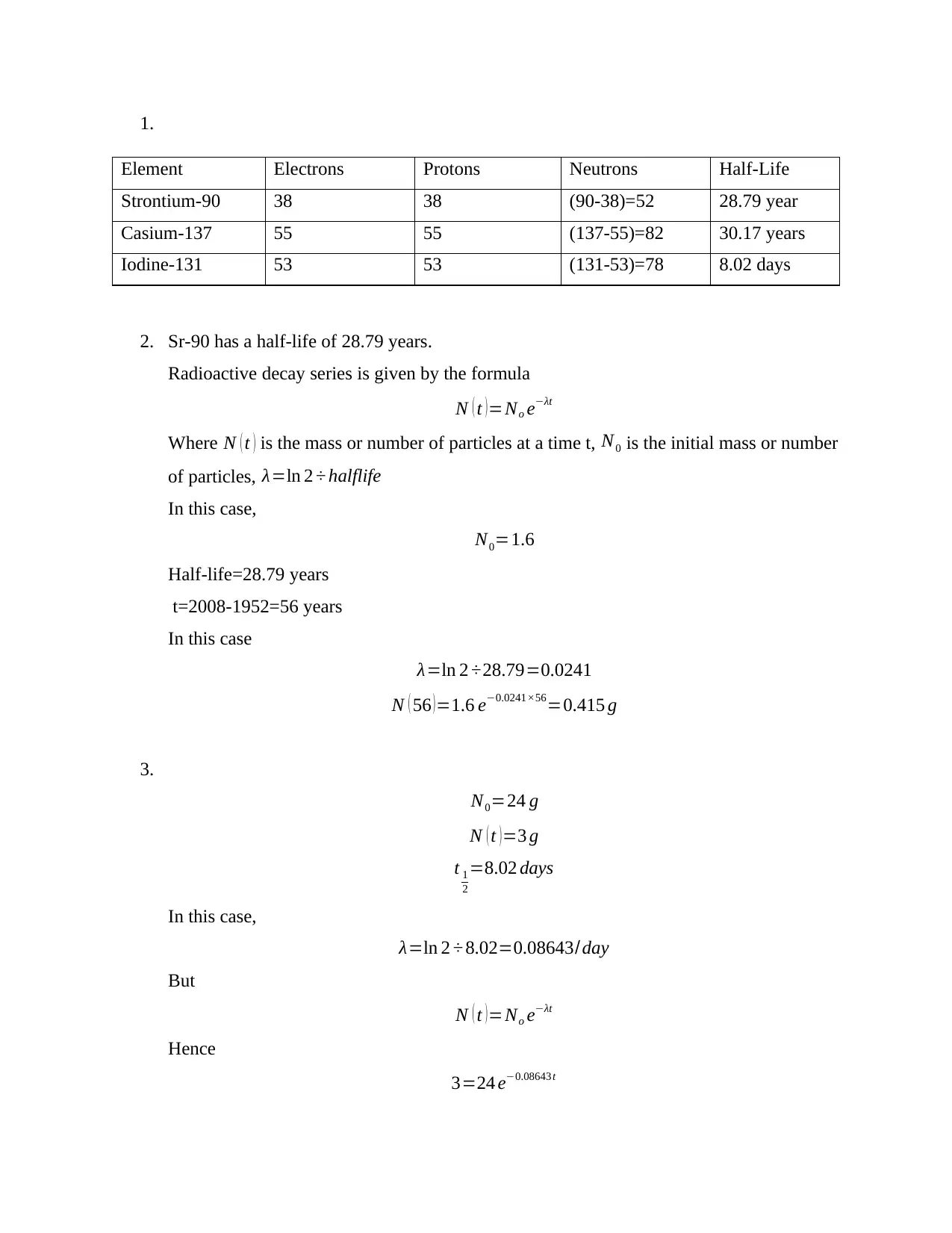
1.
Element Electrons Protons Neutrons Half-Life
Strontium-90 38 38 (90-38)=52 28.79 year
Casium-137 55 55 (137-55)=82 30.17 years
Iodine-131 53 53 (131-53)=78 8.02 days
2. Sr-90 has a half-life of 28.79 years.
Radioactive decay series is given by the formula
N ( t )=No e−λt
Where N ( t ) is the mass or number of particles at a time t, N0 is the initial mass or number
of particles, λ=ln 2 ÷ halflife
In this case,
N0=1.6
Half-life=28.79 years
t=2008-1952=56 years
In this case
λ=ln 2 ÷28.79=0.0241
N ( 56 )=1.6 e−0.0241×56=0.415 g
3.
N0=24 g
N ( t ) =3 g
t 1
2
=8.02 days
In this case,
λ=ln 2 ÷ 8.02=0.08643/day
But
N ( t )=No e−λt
Hence
3=24 e−0.08643 t
Element Electrons Protons Neutrons Half-Life
Strontium-90 38 38 (90-38)=52 28.79 year
Casium-137 55 55 (137-55)=82 30.17 years
Iodine-131 53 53 (131-53)=78 8.02 days
2. Sr-90 has a half-life of 28.79 years.
Radioactive decay series is given by the formula
N ( t )=No e−λt
Where N ( t ) is the mass or number of particles at a time t, N0 is the initial mass or number
of particles, λ=ln 2 ÷ halflife
In this case,
N0=1.6
Half-life=28.79 years
t=2008-1952=56 years
In this case
λ=ln 2 ÷28.79=0.0241
N ( 56 )=1.6 e−0.0241×56=0.415 g
3.
N0=24 g
N ( t ) =3 g
t 1
2
=8.02 days
In this case,
λ=ln 2 ÷ 8.02=0.08643/day
But
N ( t )=No e−λt
Hence
3=24 e−0.08643 t
Paraphrase This Document
Need a fresh take? Get an instant paraphrase of this document with our AI Paraphraser
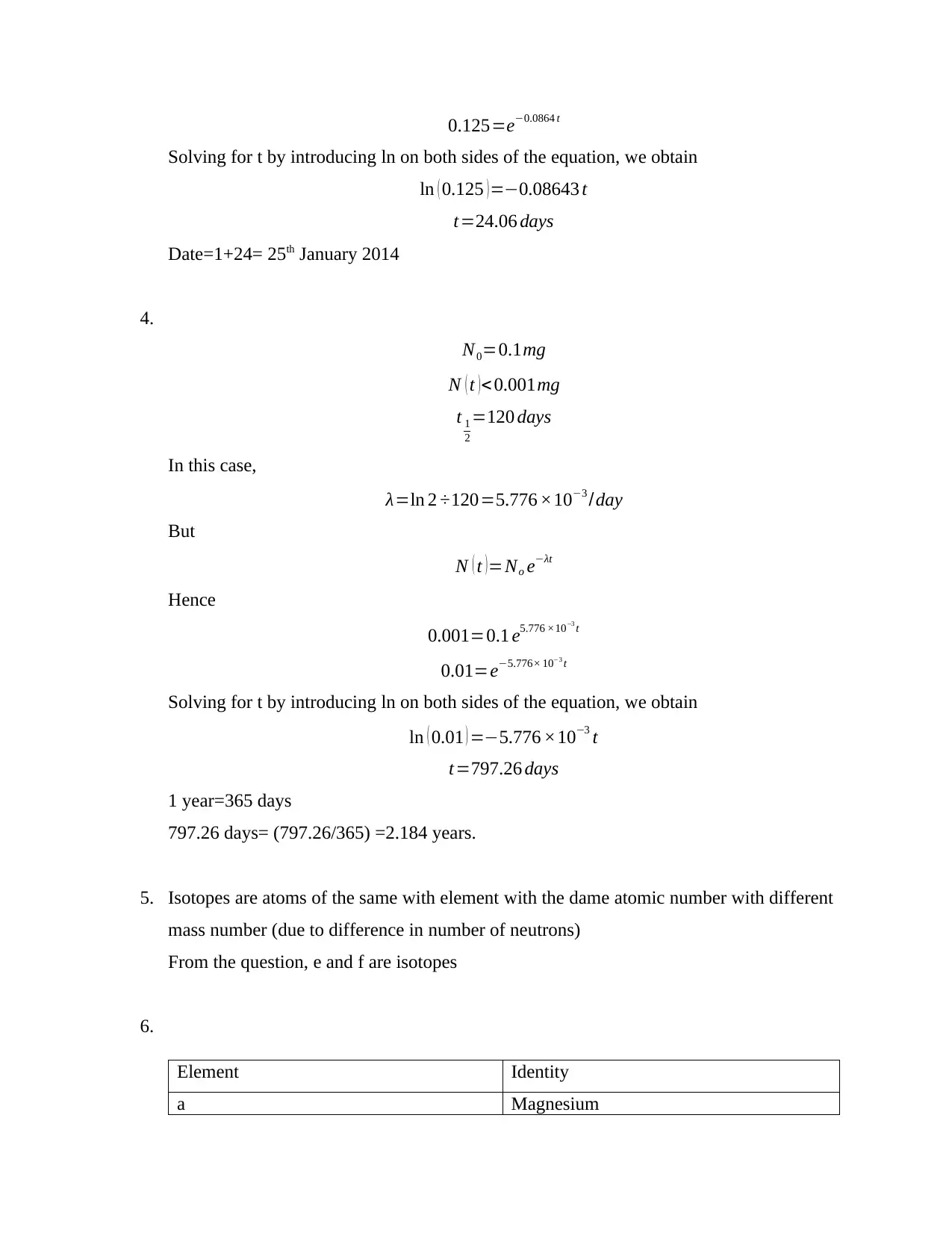
0.125=e−0.0864 t
Solving for t by introducing ln on both sides of the equation, we obtain
ln ( 0.125 )=−0.08643 t
t=24.06 days
Date=1+24= 25th January 2014
4.
N0=0.1mg
N ( t )< 0.001mg
t 1
2
=120 days
In this case,
λ=ln 2 ÷120=5.776 ×10−3 /day
But
N ( t )=No e−λt
Hence
0.001=0.1 e5.776 ×10−3 t
0.01=e−5.776× 10−3 t
Solving for t by introducing ln on both sides of the equation, we obtain
ln ( 0.01 ) =−5.776 ×10−3 t
t=797.26 days
1 year=365 days
797.26 days= (797.26/365) =2.184 years.
5. Isotopes are atoms of the same with element with the dame atomic number with different
mass number (due to difference in number of neutrons)
From the question, e and f are isotopes
6.
Element Identity
a Magnesium
Solving for t by introducing ln on both sides of the equation, we obtain
ln ( 0.125 )=−0.08643 t
t=24.06 days
Date=1+24= 25th January 2014
4.
N0=0.1mg
N ( t )< 0.001mg
t 1
2
=120 days
In this case,
λ=ln 2 ÷120=5.776 ×10−3 /day
But
N ( t )=No e−λt
Hence
0.001=0.1 e5.776 ×10−3 t
0.01=e−5.776× 10−3 t
Solving for t by introducing ln on both sides of the equation, we obtain
ln ( 0.01 ) =−5.776 ×10−3 t
t=797.26 days
1 year=365 days
797.26 days= (797.26/365) =2.184 years.
5. Isotopes are atoms of the same with element with the dame atomic number with different
mass number (due to difference in number of neutrons)
From the question, e and f are isotopes
6.
Element Identity
a Magnesium

b Carbon-12
c Chromium
d Lithium
e Sodium-24
f Sodium-23
7.
Ion Number of
protons
Number of
electrons
a Mg 12 10 (+2) Positive
b F 9 10 (-) Negative
c S 16 18 (-2) Negative
d Au 79 76 (+) Positive
8. Ionization radiation refers to a radiation that carries enough amount of energy capable of
detaching an electron or electrons from atoms or molecules thus ionizing them. It is made
up of energetic subatomic particles, either ions or atoms moving at high velocities, and
electromagnetic waves that are travelling at high energy end of the electromagnetic
spectrum.
The basic process by which ionization radiation can damage living cells.
Radiation damages living cells by two basic process. Radiation can either strike
components of a living cell such as DNA directly hence ionizing and damaging the cell.
Radiation can also ionize the water molecules thus producing free radicals that damages
the living cell.
9. Main safety concerns about a nuclear reactor
Natural disasters. Some natural disasters such as tsunamis and earthquakes can
damage nuclear power plant. Fukushima plant for instance was damaged because
c Chromium
d Lithium
e Sodium-24
f Sodium-23
7.
Ion Number of
protons
Number of
electrons
a Mg 12 10 (+2) Positive
b F 9 10 (-) Negative
c S 16 18 (-2) Negative
d Au 79 76 (+) Positive
8. Ionization radiation refers to a radiation that carries enough amount of energy capable of
detaching an electron or electrons from atoms or molecules thus ionizing them. It is made
up of energetic subatomic particles, either ions or atoms moving at high velocities, and
electromagnetic waves that are travelling at high energy end of the electromagnetic
spectrum.
The basic process by which ionization radiation can damage living cells.
Radiation damages living cells by two basic process. Radiation can either strike
components of a living cell such as DNA directly hence ionizing and damaging the cell.
Radiation can also ionize the water molecules thus producing free radicals that damages
the living cell.
9. Main safety concerns about a nuclear reactor
Natural disasters. Some natural disasters such as tsunamis and earthquakes can
damage nuclear power plant. Fukushima plant for instance was damaged because
⊘ This is a preview!⊘
Do you want full access?
Subscribe today to unlock all pages.

Trusted by 1+ million students worldwide

of the implicit consideration of seismic activity of its location (Taylor et al.,
2017). There have since been concerns on seismic studies of older plant including
studies on tornados and hurricanes.
Security related issues. Majority of the countries that uses nuclear power have
signed Nuclear Nonproliferation Treaty and have agreed to comply to its terms.
Since the 9/11 catastrophe, there have been concerns on nuclear plants (Taylor et
al., 2017). There have thus been concerns on maintain nuclear plants safer by
using more stringent security measures.
Nuclear Waste. Both the short and long term storage of spent nuclear fuel have
been a challenge to both the industry and policy makers. Improper disposal of
nuclear waste pollutes water supplies and in wrong hands, there have been threats
from dirty bombs created from such materials. There have been concerns on
packing fuel rods in pools that surpasses the design specifications (Kyne & Bolin,
2016).
Meltdowns and accidents. Human errors such as design flaws have triggered some
of the most outstanding safety breaches in nuclear plants for example the
Chernobyl explosion (Kyne & Bolin, 2016,). There have thus been concerns to
improve nuclear power safe by limiting the chances of meltdowns and accidents.
10. Kinds of radioactive radiations known to mankind
Alpha radiations. This involves a radiation of a helium ion (alpha particles) leaving the
nucleus of the daughter atom two atomic number less than the parent atom for example
Beta radiation. In this radiation, an energetic negative electron is emitted producing a
daughter nucleus with one higher atomic number for example
2017). There have since been concerns on seismic studies of older plant including
studies on tornados and hurricanes.
Security related issues. Majority of the countries that uses nuclear power have
signed Nuclear Nonproliferation Treaty and have agreed to comply to its terms.
Since the 9/11 catastrophe, there have been concerns on nuclear plants (Taylor et
al., 2017). There have thus been concerns on maintain nuclear plants safer by
using more stringent security measures.
Nuclear Waste. Both the short and long term storage of spent nuclear fuel have
been a challenge to both the industry and policy makers. Improper disposal of
nuclear waste pollutes water supplies and in wrong hands, there have been threats
from dirty bombs created from such materials. There have been concerns on
packing fuel rods in pools that surpasses the design specifications (Kyne & Bolin,
2016).
Meltdowns and accidents. Human errors such as design flaws have triggered some
of the most outstanding safety breaches in nuclear plants for example the
Chernobyl explosion (Kyne & Bolin, 2016,). There have thus been concerns to
improve nuclear power safe by limiting the chances of meltdowns and accidents.
10. Kinds of radioactive radiations known to mankind
Alpha radiations. This involves a radiation of a helium ion (alpha particles) leaving the
nucleus of the daughter atom two atomic number less than the parent atom for example
Beta radiation. In this radiation, an energetic negative electron is emitted producing a
daughter nucleus with one higher atomic number for example
Paraphrase This Document
Need a fresh take? Get an instant paraphrase of this document with our AI Paraphraser
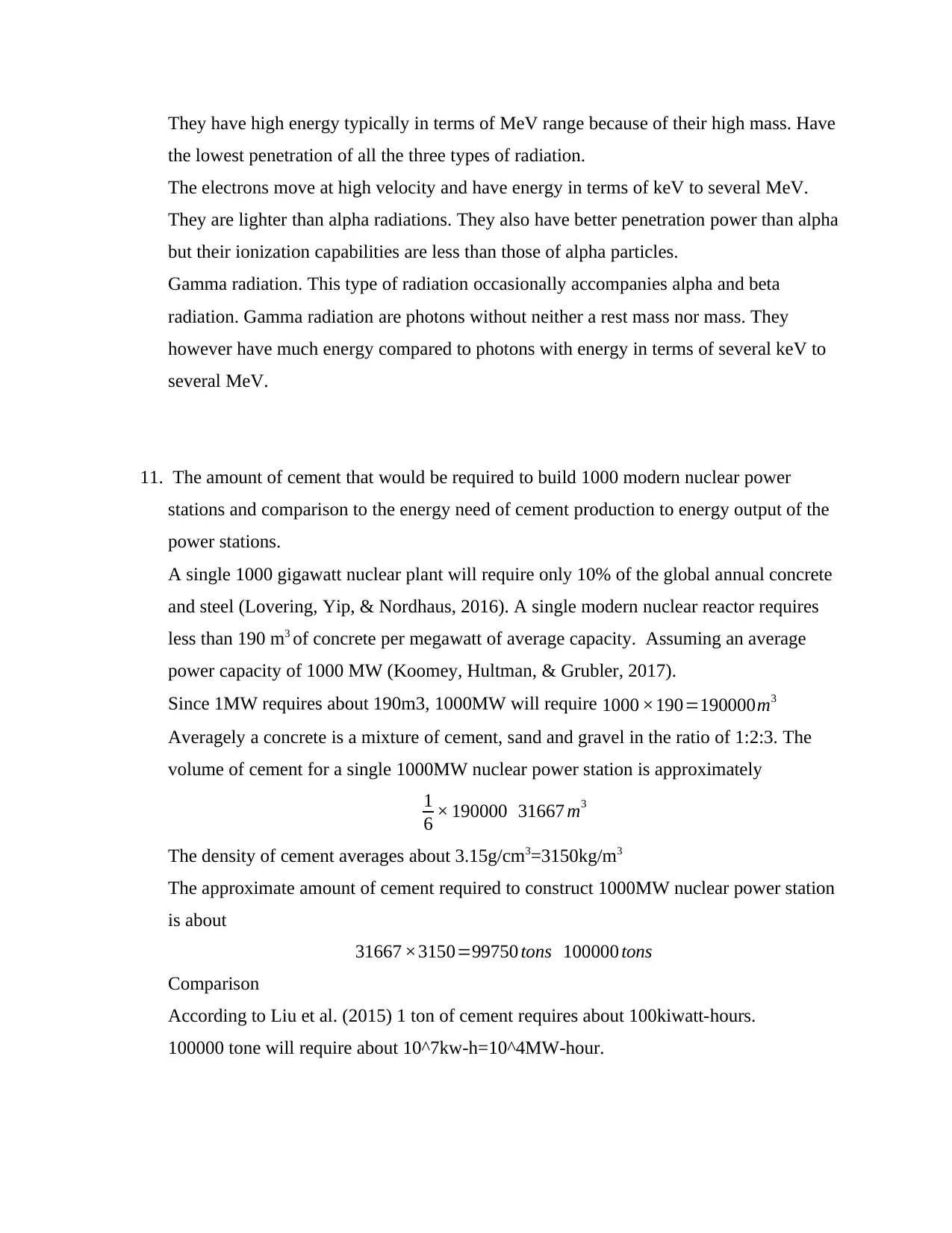
They have high energy typically in terms of MeV range because of their high mass. Have
the lowest penetration of all the three types of radiation.
The electrons move at high velocity and have energy in terms of keV to several MeV.
They are lighter than alpha radiations. They also have better penetration power than alpha
but their ionization capabilities are less than those of alpha particles.
Gamma radiation. This type of radiation occasionally accompanies alpha and beta
radiation. Gamma radiation are photons without neither a rest mass nor mass. They
however have much energy compared to photons with energy in terms of several keV to
several MeV.
11. The amount of cement that would be required to build 1000 modern nuclear power
stations and comparison to the energy need of cement production to energy output of the
power stations.
A single 1000 gigawatt nuclear plant will require only 10% of the global annual concrete
and steel (Lovering, Yip, & Nordhaus, 2016). A single modern nuclear reactor requires
less than 190 m3 of concrete per megawatt of average capacity. Assuming an average
power capacity of 1000 MW (Koomey, Hultman, & Grubler, 2017).
Since 1MW requires about 190m3, 1000MW will require 1000 ×190=190000m3
Averagely a concrete is a mixture of cement, sand and gravel in the ratio of 1:2:3. The
volume of cement for a single 1000MW nuclear power station is approximately
1
6 × 190000 31667 m3
The density of cement averages about 3.15g/cm3=3150kg/m3
The approximate amount of cement required to construct 1000MW nuclear power station
is about
31667 ×3150=99750 tons 100000 tons
Comparison
According to Liu et al. (2015) 1 ton of cement requires about 100kiwatt-hours.
100000 tone will require about 10^7kw-h=10^4MW-hour.
the lowest penetration of all the three types of radiation.
The electrons move at high velocity and have energy in terms of keV to several MeV.
They are lighter than alpha radiations. They also have better penetration power than alpha
but their ionization capabilities are less than those of alpha particles.
Gamma radiation. This type of radiation occasionally accompanies alpha and beta
radiation. Gamma radiation are photons without neither a rest mass nor mass. They
however have much energy compared to photons with energy in terms of several keV to
several MeV.
11. The amount of cement that would be required to build 1000 modern nuclear power
stations and comparison to the energy need of cement production to energy output of the
power stations.
A single 1000 gigawatt nuclear plant will require only 10% of the global annual concrete
and steel (Lovering, Yip, & Nordhaus, 2016). A single modern nuclear reactor requires
less than 190 m3 of concrete per megawatt of average capacity. Assuming an average
power capacity of 1000 MW (Koomey, Hultman, & Grubler, 2017).
Since 1MW requires about 190m3, 1000MW will require 1000 ×190=190000m3
Averagely a concrete is a mixture of cement, sand and gravel in the ratio of 1:2:3. The
volume of cement for a single 1000MW nuclear power station is approximately
1
6 × 190000 31667 m3
The density of cement averages about 3.15g/cm3=3150kg/m3
The approximate amount of cement required to construct 1000MW nuclear power station
is about
31667 ×3150=99750 tons 100000 tons
Comparison
According to Liu et al. (2015) 1 ton of cement requires about 100kiwatt-hours.
100000 tone will require about 10^7kw-h=10^4MW-hour.
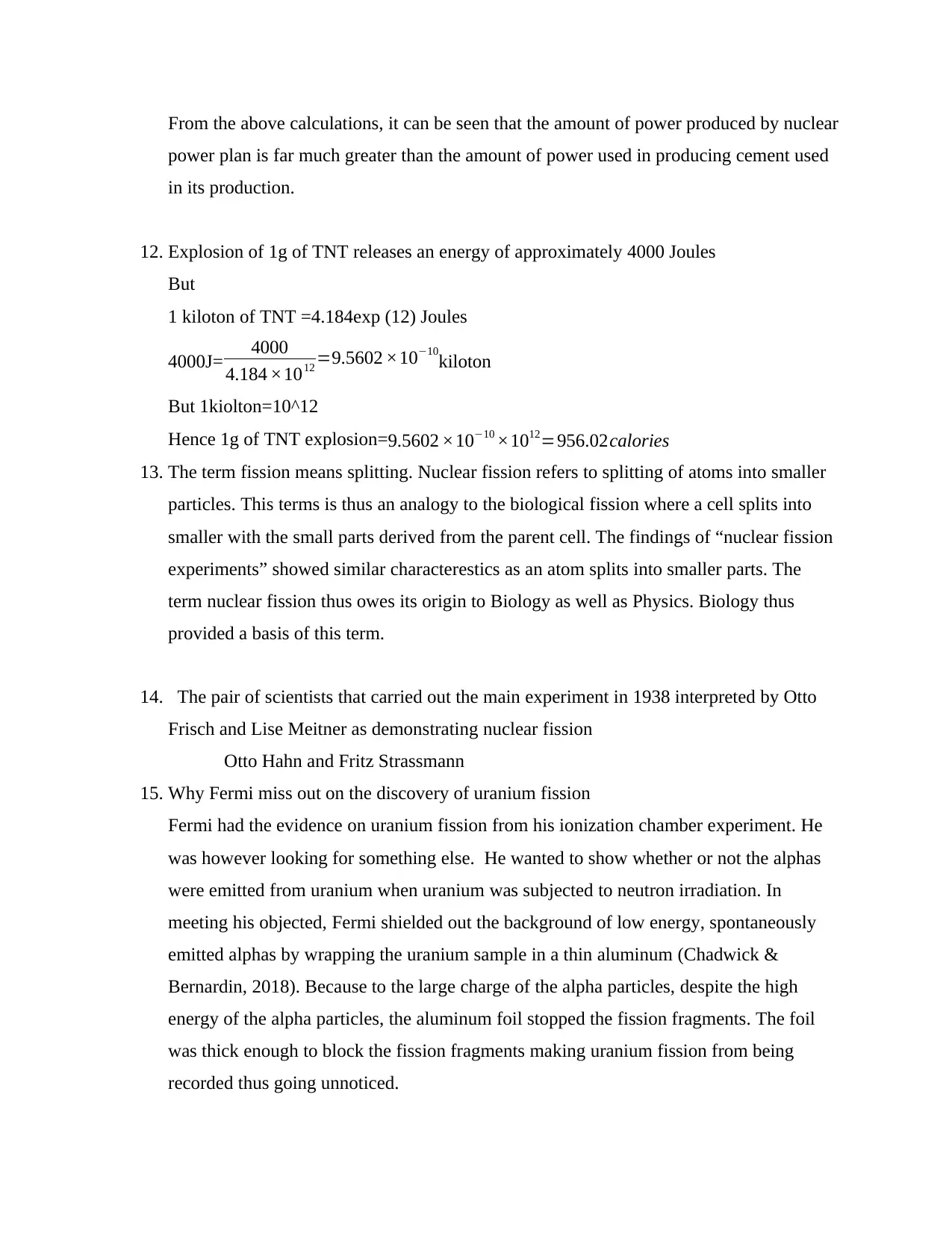
From the above calculations, it can be seen that the amount of power produced by nuclear
power plan is far much greater than the amount of power used in producing cement used
in its production.
12. Explosion of 1g of TNT releases an energy of approximately 4000 Joules
But
1 kiloton of TNT =4.184exp (12) Joules
4000J= 4000
4.184 ×1012 =9.5602 ×10−10
kiloton
But 1kiolton=10^12
Hence 1g of TNT explosion=9.5602 ×10−10 ×1012=956.02calories
13. The term fission means splitting. Nuclear fission refers to splitting of atoms into smaller
particles. This terms is thus an analogy to the biological fission where a cell splits into
smaller with the small parts derived from the parent cell. The findings of “nuclear fission
experiments” showed similar characterestics as an atom splits into smaller parts. The
term nuclear fission thus owes its origin to Biology as well as Physics. Biology thus
provided a basis of this term.
14. The pair of scientists that carried out the main experiment in 1938 interpreted by Otto
Frisch and Lise Meitner as demonstrating nuclear fission
Otto Hahn and Fritz Strassmann
15. Why Fermi miss out on the discovery of uranium fission
Fermi had the evidence on uranium fission from his ionization chamber experiment. He
was however looking for something else. He wanted to show whether or not the alphas
were emitted from uranium when uranium was subjected to neutron irradiation. In
meeting his objected, Fermi shielded out the background of low energy, spontaneously
emitted alphas by wrapping the uranium sample in a thin aluminum (Chadwick &
Bernardin, 2018). Because to the large charge of the alpha particles, despite the high
energy of the alpha particles, the aluminum foil stopped the fission fragments. The foil
was thick enough to block the fission fragments making uranium fission from being
recorded thus going unnoticed.
power plan is far much greater than the amount of power used in producing cement used
in its production.
12. Explosion of 1g of TNT releases an energy of approximately 4000 Joules
But
1 kiloton of TNT =4.184exp (12) Joules
4000J= 4000
4.184 ×1012 =9.5602 ×10−10
kiloton
But 1kiolton=10^12
Hence 1g of TNT explosion=9.5602 ×10−10 ×1012=956.02calories
13. The term fission means splitting. Nuclear fission refers to splitting of atoms into smaller
particles. This terms is thus an analogy to the biological fission where a cell splits into
smaller with the small parts derived from the parent cell. The findings of “nuclear fission
experiments” showed similar characterestics as an atom splits into smaller parts. The
term nuclear fission thus owes its origin to Biology as well as Physics. Biology thus
provided a basis of this term.
14. The pair of scientists that carried out the main experiment in 1938 interpreted by Otto
Frisch and Lise Meitner as demonstrating nuclear fission
Otto Hahn and Fritz Strassmann
15. Why Fermi miss out on the discovery of uranium fission
Fermi had the evidence on uranium fission from his ionization chamber experiment. He
was however looking for something else. He wanted to show whether or not the alphas
were emitted from uranium when uranium was subjected to neutron irradiation. In
meeting his objected, Fermi shielded out the background of low energy, spontaneously
emitted alphas by wrapping the uranium sample in a thin aluminum (Chadwick &
Bernardin, 2018). Because to the large charge of the alpha particles, despite the high
energy of the alpha particles, the aluminum foil stopped the fission fragments. The foil
was thick enough to block the fission fragments making uranium fission from being
recorded thus going unnoticed.
⊘ This is a preview!⊘
Do you want full access?
Subscribe today to unlock all pages.

Trusted by 1+ million students worldwide
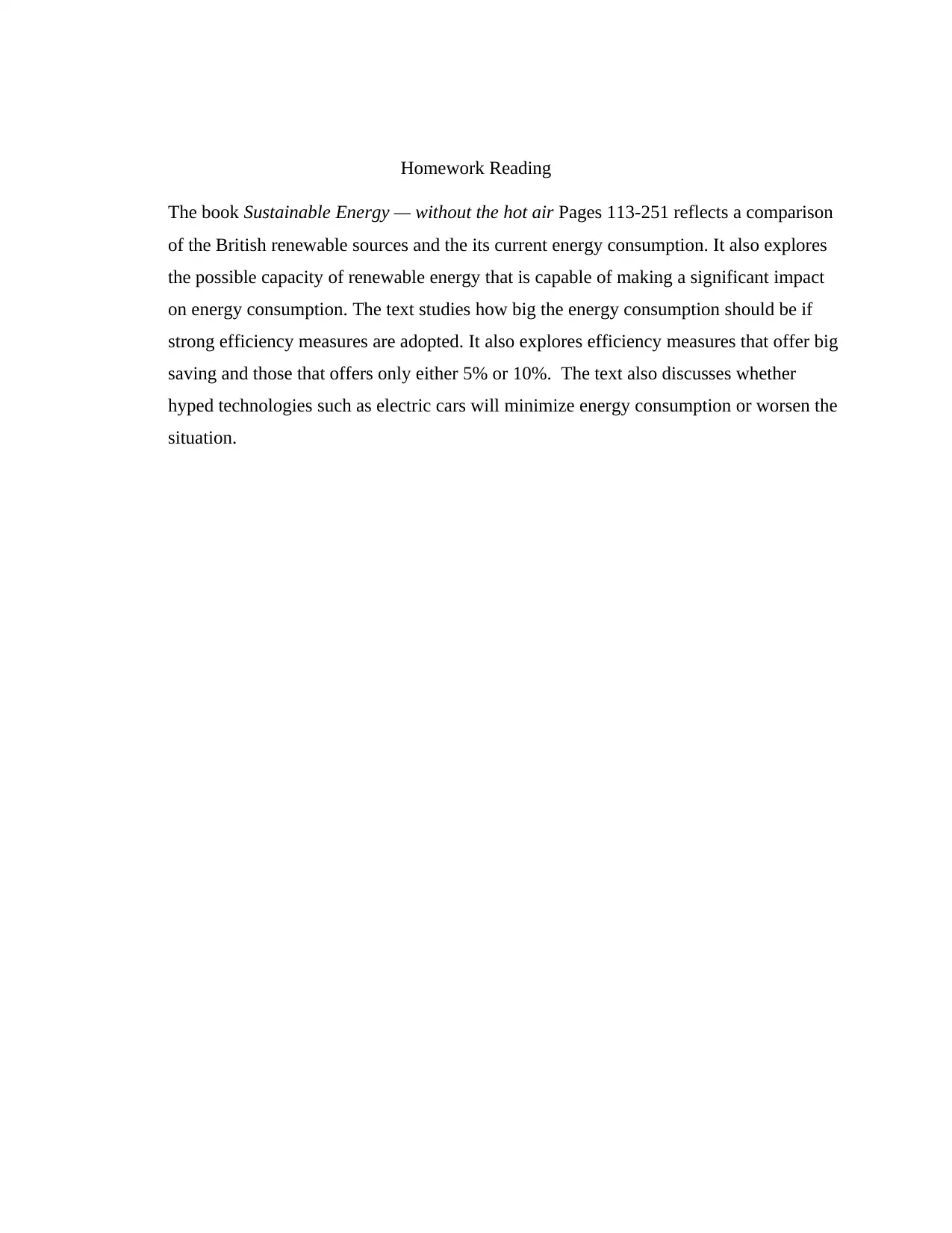
Homework Reading
The book Sustainable Energy — without the hot air Pages 113-251 reflects a comparison
of the British renewable sources and the its current energy consumption. It also explores
the possible capacity of renewable energy that is capable of making a significant impact
on energy consumption. The text studies how big the energy consumption should be if
strong efficiency measures are adopted. It also explores efficiency measures that offer big
saving and those that offers only either 5% or 10%. The text also discusses whether
hyped technologies such as electric cars will minimize energy consumption or worsen the
situation.
The book Sustainable Energy — without the hot air Pages 113-251 reflects a comparison
of the British renewable sources and the its current energy consumption. It also explores
the possible capacity of renewable energy that is capable of making a significant impact
on energy consumption. The text studies how big the energy consumption should be if
strong efficiency measures are adopted. It also explores efficiency measures that offer big
saving and those that offers only either 5% or 10%. The text also discusses whether
hyped technologies such as electric cars will minimize energy consumption or worsen the
situation.
Paraphrase This Document
Need a fresh take? Get an instant paraphrase of this document with our AI Paraphraser

References
Chadwick, M. B., & Bernardin, M. P. (2018). Top Ten Weapons Breakthrough in Los Alamos'
History (No. LA-UR-18-29606). Los Alamos National Lab.(LANL), Los Alamos, NM
(United States).
Koomey, J., Hultman, N. E., & Grubler, A. (2017). A reply to “Historical construction costs of
global nuclear power reactors”. Energy Policy, 102, 640-643.
Kyne, D., & Bolin, B. (2016). Emerging Environmental Justice Issues in Nuclear Power and
Radioactive Contamination. International Journal of Environmental Research and
Public Health, 13(7), 700.
Liu, Z., Guan, D., Wei, W., Davis, S. J., Ciais, P., Bai, J., … He, K. (2015). Reduced carbon
emission estimates from fossil fuel combustion and cement production in China. Nature,
524(7565), 335-338.
Lovering, J. R., Yip, A., & Nordhaus, T. (2016). Historical construction costs of global nuclear
power reactors. Energy Policy, 91, 371-382.
Taylor, N., Ciattaglia, S., Boyer, H., Coombs, D., Jin, X. Z., Liger, K., … Urbonavičius, E.
(2017). Resolving safety issues for a demonstration fusion power plant. Fusion
Engineering and Design, 124, 1177-1180.
Chadwick, M. B., & Bernardin, M. P. (2018). Top Ten Weapons Breakthrough in Los Alamos'
History (No. LA-UR-18-29606). Los Alamos National Lab.(LANL), Los Alamos, NM
(United States).
Koomey, J., Hultman, N. E., & Grubler, A. (2017). A reply to “Historical construction costs of
global nuclear power reactors”. Energy Policy, 102, 640-643.
Kyne, D., & Bolin, B. (2016). Emerging Environmental Justice Issues in Nuclear Power and
Radioactive Contamination. International Journal of Environmental Research and
Public Health, 13(7), 700.
Liu, Z., Guan, D., Wei, W., Davis, S. J., Ciais, P., Bai, J., … He, K. (2015). Reduced carbon
emission estimates from fossil fuel combustion and cement production in China. Nature,
524(7565), 335-338.
Lovering, J. R., Yip, A., & Nordhaus, T. (2016). Historical construction costs of global nuclear
power reactors. Energy Policy, 91, 371-382.
Taylor, N., Ciattaglia, S., Boyer, H., Coombs, D., Jin, X. Z., Liger, K., … Urbonavičius, E.
(2017). Resolving safety issues for a demonstration fusion power plant. Fusion
Engineering and Design, 124, 1177-1180.
1 out of 8
Your All-in-One AI-Powered Toolkit for Academic Success.
+13062052269
info@desklib.com
Available 24*7 on WhatsApp / Email
![[object Object]](/_next/static/media/star-bottom.7253800d.svg)
Unlock your academic potential
Copyright © 2020–2025 A2Z Services. All Rights Reserved. Developed and managed by ZUCOL.